Tale of Kindness Didn’t Fit Notion of Savage Indian
In a boarding house in El Monte, before the Civil War, a young woman held court, recounting a tale of living among Indians who had treated her kindly--an unimaginable concept in the frontier West.
Olive Oatman, “Cloudwoman” to the tribe of Mojave Indians among whom she had lived, had been unrecognizable when she returned to white society: bare-breasted, wearing a bark skirt, tanned and painted skin and with an indelible dark blue tattoo covering her chin.
Almost 30 years before Helen Hunt Jackson’s books and lectures called attention to the mistreatment of native Californians, Olive’s own story of suffering, survival and friendship only evoked fear and fascination in a western society that considered her “disfigured” and her Indian friends savages.
As a 13-year-old girl, Olive had witnessed the bloody massacre of her family by Yavapai Indians who first made her a slave, then traded her to the Mojaves, who treated her far better.
On Aug. 10, 1850, Royse Oatman, his wife and seven children had joined a wagon train at Independence, Mo., led by James Collins Brewster, leader of an excommunicated Mormon sect called Brewsterites. Brewster and his party were headed for “Bashan,” at the mouth of the Colorado River, a spot Brewster said had been divinely revealed to him.
But when quarreling started, the group split up. Eight wagons and 20 people, among them the Oatmans, turned south for a new destination: California. Their food gave out, their livestock was stolen but, finally, leaving two other families behind, the Oatmans made their way across Arizona.
On Feb. 19, 1851, 80 miles east of Fort Yuma on a plateau 60 feet above the Gila River, the Oatmans ate a sparse meal of bread and bean soup. As they packed up to leave, 17 Yavapai warriors rode up. The Indians dismounted and sat down to smoke and talk. But when Royse Oatman refused to share what little food was left, the offended Indians huddled together.
Suddenly, with a “fiendish yell,” Olive later recounted, they attacked. Thirteen-year-old Olive and her 7-year-old sister, Mary Ann, were pushed aside. As they watched in horror, an Indian crushed their father’s skull with a club.
Their pregnant mother, holding their 2-year-old brother, was dragged from the wagon and both were beaten to death. Their 14-year-old brother, Lorenzo, lay on the ground, his head bloodied. The girls watched their three remaining siblings killed with rocks, a spear and clubs.
(Lorenzo would survive the attack, suffering blinding headaches and blackouts for the rest of his life.)
Forced to take off their shoes to discourage escape and to avoid leaving telltale shoe prints, the girls, sunburned and sweat-soaked, were marched for three days, stumbling at last on bleeding feet into their captors’ camp near Congress, Ariz. A greeting party tied the girls together atop a pile of brush and sticks, while others danced in triumph around them, spitting in their faces and screaming.
Having been beaten, starved and worked like slaves for a year, in 1852 the girls were sold to a Mojave tribe for two horses, some vegetables, several pounds of beads and three blankets. Their new owners walked them for 11 days across the desert to the Mojave Valley, near the site of what is now Needles, Calif., which was then part of the vast new Los Angeles County.
What began as a slave sale turned out to be a rescue. Adopted into the Mojave chief’s family, the Oatman sisters “. . . were treated in every respect as his own children,” she recalled. To complete their adoption and ensure a happy afterlife, the girls were tattooed, like all Mojave women.
Five vertical lines were cut from Olive’s lower lip to the bottom of her chin. A mixture of powdered stone and herbs was rubbed into the lines, and a slender triangle was etched at each corner of her mouth, with two more at the jaw line. After a single blue decorative line was tattooed on her upper arms, Olive was given her Mojave clan name: Cloudwoman.
A year later, famine killed many Mojaves and 10-year-old Mary Ann Oatman. As she lay dying, her adopted mother “wept and wept from the heart and aloud . . . for a whole night,” Olive recalled.
Olive, protesting the Mojave custom of cremation, was permitted to bury her sister near what became the Needles railroad station. Grieving and starving, Olive might have died too, if her Indian mother hadn’t secretly hand-fed her with ground-up seed corn.
In early 1856, a Yuma Indian working for the U.S. Army spotted Olive and negotiated her exchange, offering a white horse, four blankets, six pounds of white beads and some trinkets as a gift. Her adoptive father agreed to let Olive go, believing that her release would bring them many white friends after Americans saw how well she had been treated.
At a footbridge over the Colorado River, a crowd of Mojave Indians gathered to say goodbye. Torn between two cultures, Olive reluctantly left and journeyed to Fort Yuma for a reunion with her brother, Lorenzo, who had been living in El Monte and had read about her release in the Los Angeles Star.
“I could not leave the wilde mountain home without a struggle,” Olive wrote. “Every stream and mountain park and shaded glen I was as familiar with, as with the dooryard of my childhood home. Those grand old solitudes possessed a peculiar charm for me.”
Back in El Monte, Olive’s captivity was big news. Reporters from across the nation flocked to her for interviews. A bill was adopted by the Legislature setting aside $1,500 to help her get started in her new life. (The money never reached her, and no one knows where it went.)
*
On June 21, 1856, the Oatmans boarded the steamship Senator at San Pedro and headed for Oregon to join relatives. Along the way, they met the Rev. Royal B. Stratton, who convinced them that a book about their experiences should be written--and he would gladly write it.
When “The Captivity of the Oatman Girls” was published in 1857, selling 30,000 copies, Olive and Lorenzo toured the country promoting it. As it turned out, Olive--and her Mojave family--were more refined than the audiences who gathered to hear her and to gawk rudely. Many refused to believe her account of affection and respect, choosing to think she had been battered, starved, raped and brainwashed.
Just before the Civil War ended, Olive visited a Mojave friend, Beautiful Bird, who had recently been made a chief. “We met, as friends giving the left hand in friendship, which is held as a sacred pledge among some tribes,” she said.
Soon after, she married John Brant Fairchild and retired from public speaking. Her husband soon bought up as many copies of her book as he could, along with “souvenir” photos of her, and burned them, seeking to protect her privacy.
To escape the curiosity of strangers, Olive always wore a heavy dark veil and soon passed into welcome obscurity. Olive died, forgotten, in Sherman, Texas, in 1903.
While her story was largely forgotten by mainstream white America, Mojave Indians still passed along the tale of Cloudwoman.
More to Read
Sign up for Essential California
The most important California stories and recommendations in your inbox every morning.
You may occasionally receive promotional content from the Los Angeles Times.










